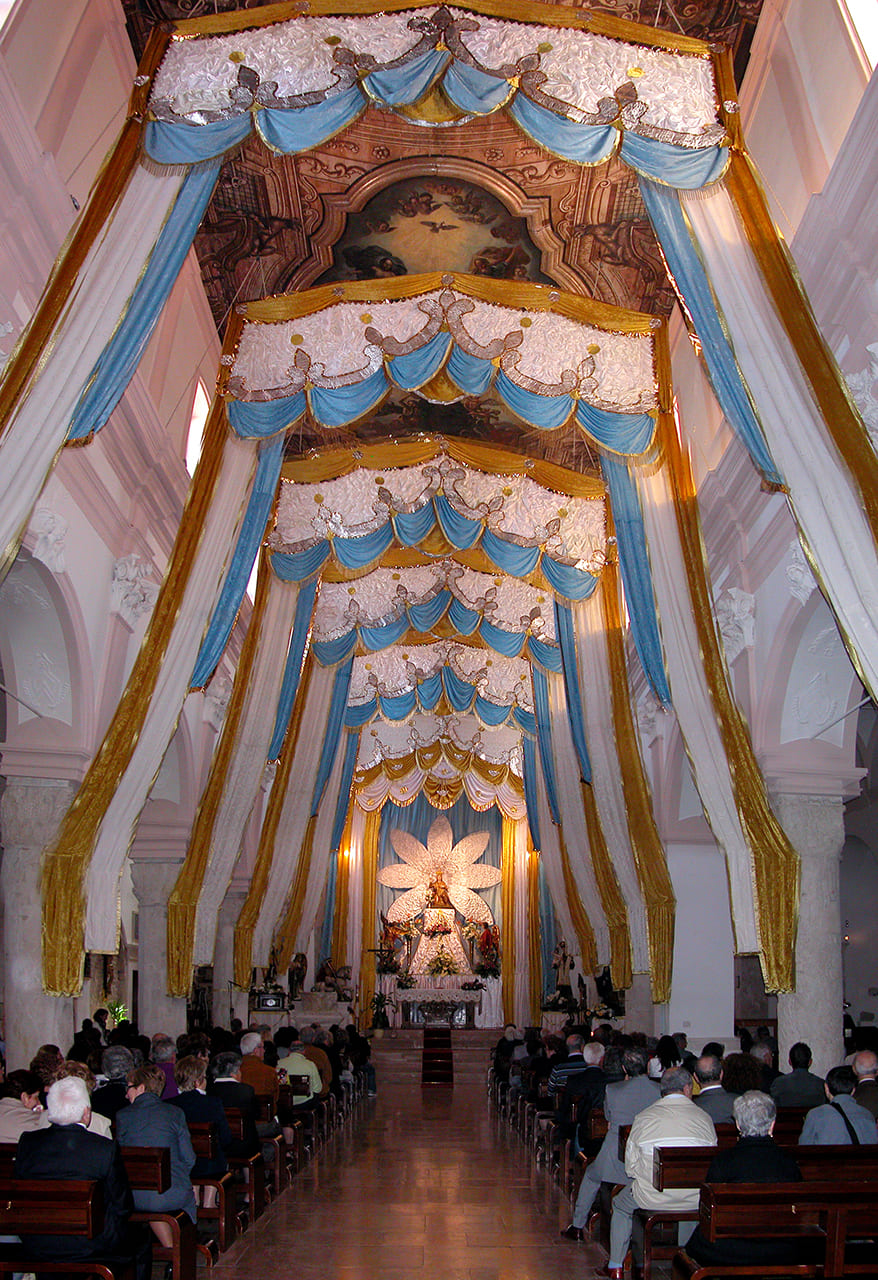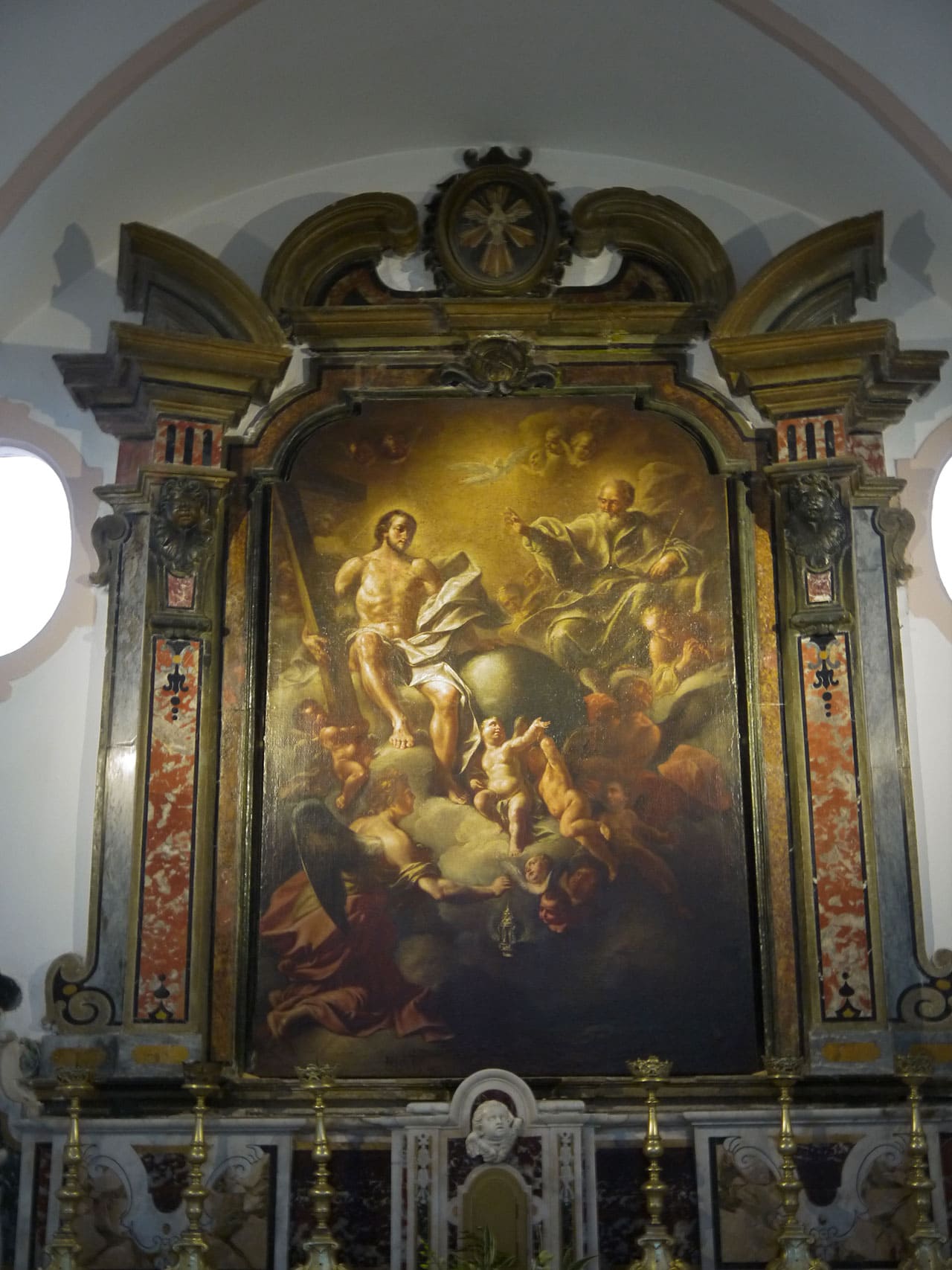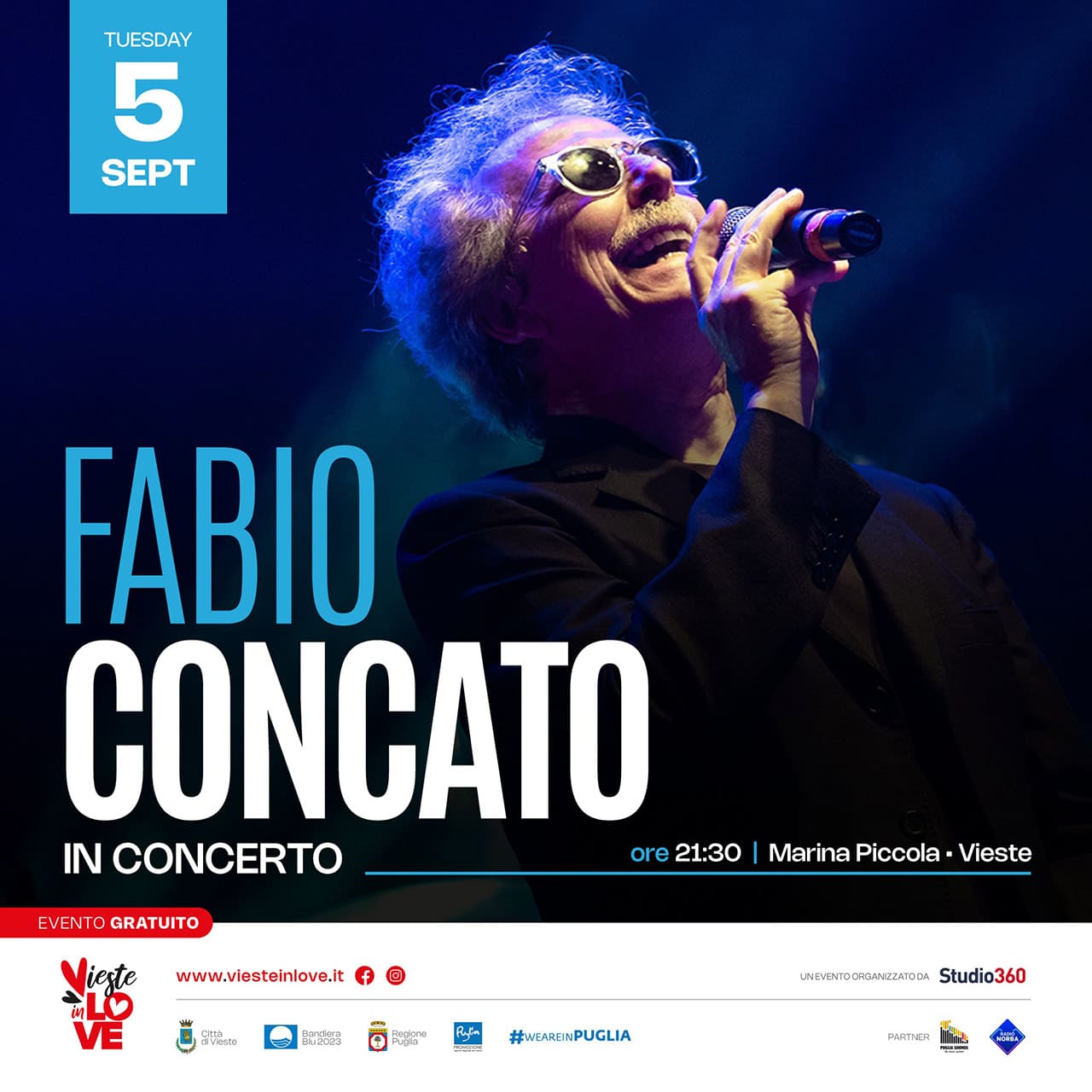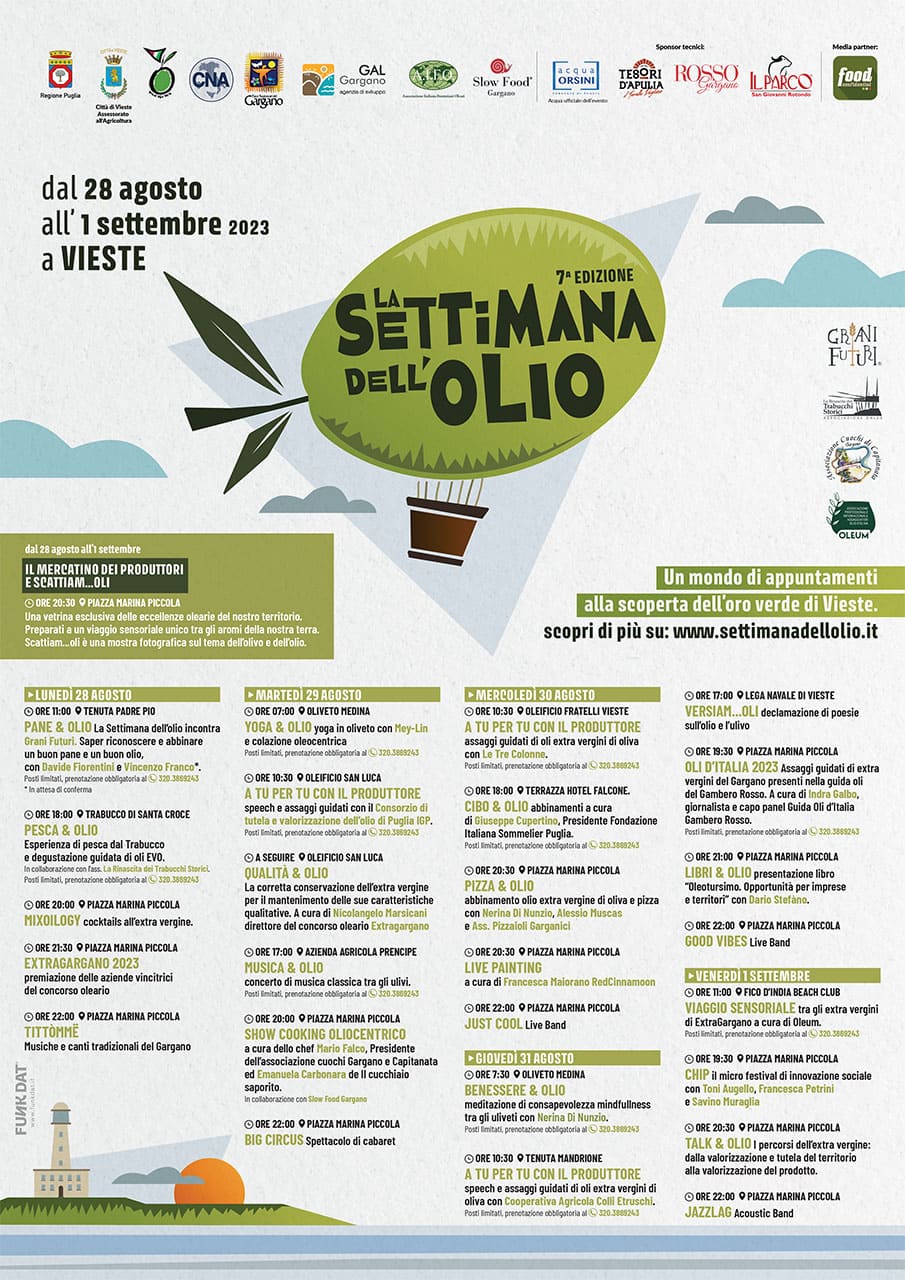La Basilica Cattedrale di Vieste, dedicata a Santa Maria Assunta in Cielo, è stata edificata intorno all’anno Mille e successivamente rimaneggiata in seguito a distruzioni e saccheggi. Della costruzione originaria oggi restano la parete settentrionale decorata con fregi, la cornice dell’ingresso laterale affiancato da due protomi leonine, la monofora strombata mentre all’interno sono da notare i capitelli e le colonne che dividono la chiesa in tre navate. I capitelli sono databili alla prima metà dell’XI secolo e presentano decorazioni di grande finezza in cui si notano figure di animali e motivi floreali simili al filone campano beneventano piuttosto che pugliesi con decorazioni tratte dall’oreficeria barbarica molto vicini al gusto orientale arabo. Di particolare rilievo sono i capitelli della quinta e sesta fila a destra e, il secondo, di quella a sinistra. Intorno al Trecento inizia la trasformazione dell’edificio con la realizzazione delle cappelle laterali e la modifica delle tre absidi. Questo è solo l’inizio di una lunga serie di trasformazioni dovute a diversi eventi nefasti che segnarono la storia di Vieste. Da ricordare sono : il saccheggio veneziano del 1239 a cui si aggiungono quelli dei pirati turchi del 1480 e del 1554, i terremoti del 1223 e del 1646 che distrusse la facciata romanica, il campanile ed un terzo della chiesa. Nella seconda metà del Settecento i vescovi Cimaglia, e il suo successore Maruca, coprirono la chiesa d’intonaco e l’abbellirono con stucchi, cornici, altari in marmo intarsiato e un soffitto dipinto in stile tardo barocco napoletano. Diverse sono le opere di rilievo conservate all’interno come la Pala del Rosario del genovese Michele Manchelli risalente al 1581, le settecentesche tele della Trinità del Tomaiuolo e la sacra conversazione di scuola veneta nelle cappelle in fondo alle navate laterali. Nella Cappella del Popolo si venera invece la pregiata statua lignea di Santa Maria di Merino, protettrice della città insieme a San Giorgio. L’attuale campanile invece sostituisce quello originale caduto durante il terremoto del 1646, riedificato, subì un crollo parziale nel 1772, a cui seguirono dei lavori che si conclusero nel 1814.
The Cathedral of Vieste, dedicated to Santa Maria Assunta in Cielo, was built around the year 1000 and later reworked following destruction and looting. Nowadays of the original building remains the northern wall decorated with friezes, the frame of the side entrance flanked by two leonine protomes, the trumpeted monophora while inside there are the capitals and columns that divide the church into three naves. The capitals can be dated to the first half of the 11th century and have decorations in which you can see figures similar to the Campanian strand of Beneventan rather than Apulian with decorations taken from the barbaric goldsmiths very close to the Eastern Arabic taste. Of particular note are the capitals of the fifth and sixth rows on the right side and, the second, of the the left one. Around the fourteenth century begins the transformation of the building with the construction of the chapels and the modification of the three apses. This is just the beginning of a long series of transformations due to several events that marked Vieste’s history. To remember are: the Venetian sack of 1239 to which are added those of the Turkish pirates of 1480 and 1554, the earthquakes of 1223 and 1646 that destroyed the Romanesque façade, the bell tower and one third of the church. In the second half of the eighteenth century the bishop Cimaglia, and his successor Maruca, covered the plaster church and with decorated stuccoes, frames, intarsiated marble altars and a ceiling painted in the late Neapolitan Baroque style. There are several important works inside such as the altarpiece of the Rosary painted by Michele Manchelli dating back to 1581, the eighteenth-century canvases of the Trinity of Tomaiuolo and the sacred conversation of venetian school in the chapels at the bottom of the aisles. In the People’s Chapelis is located the precious wooden statue of Santa Maria di Merino, protectress of the city together with St. George. The current bell tower instead replaces the original one that fell during the earthquake of 1646, rebuilt, suffered a partial collapse in 1772, followed by works that ended in 1814.
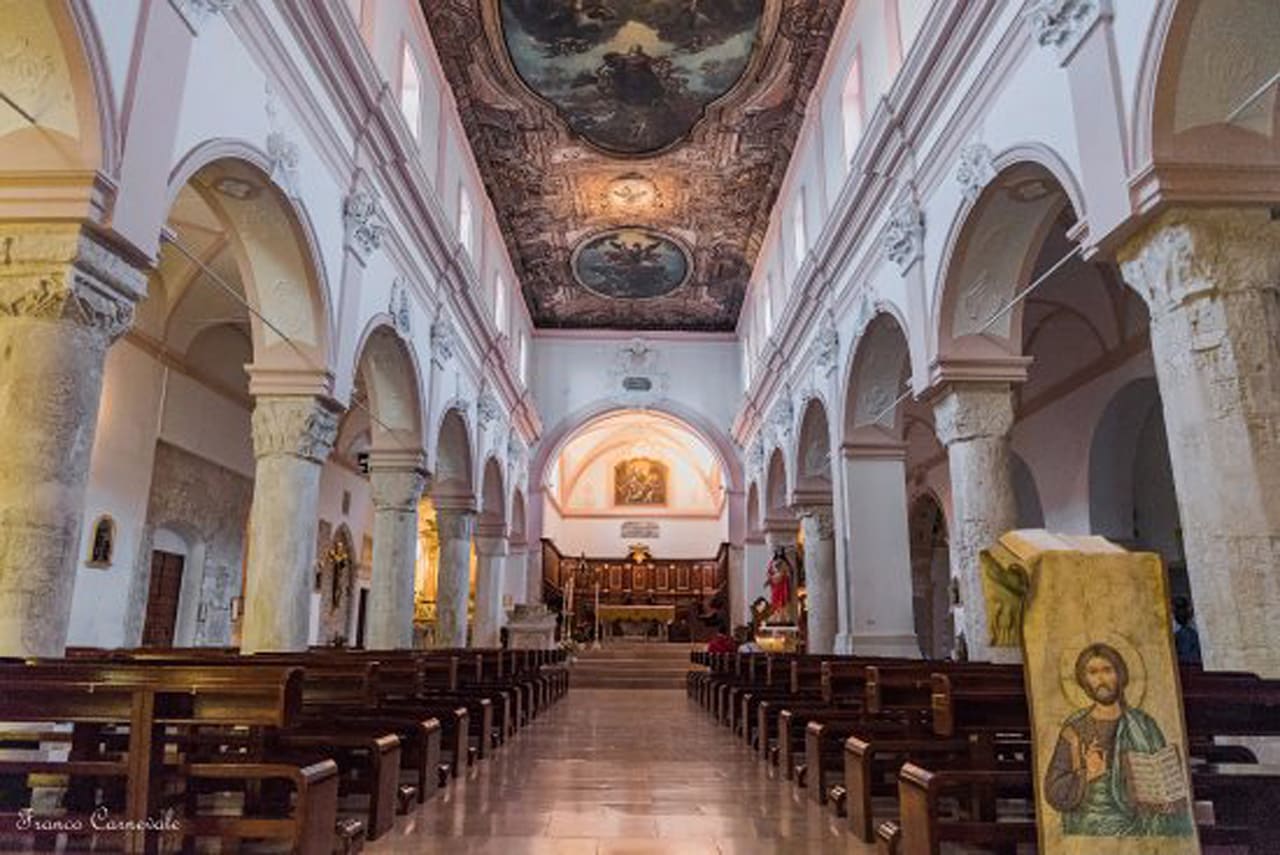
MULTIMEDIALE
Si accede dall’ingresso principale e la visita inizia sul lato sinistro dove ci sono due teche che ospitano le “Casse” della Madonna (1) usate per portare in solenne processione la protettrice della città. La prima è quella grande o di città portata a spalla dai confratelli in paese, l’altra più piccola è detta di campagna e viene portata a spalla dal popolo. Queste due opere sono realizzate da artisti locali e sono da considerare come delle vere e proprie opere d’arte per la loro originalità e simbologia. Si continua con la Cappella del Battistero (2), la più antica della chiesa con la fonte battesimale in marmo con coperchio in legno decorata in finto marmo opera dei marmorari napoletani Barone. Si può ammirare anche l’imponente statua dell’Immacolata di Nicolantonio Brudaglio (1756) è una delle più importanti opere di questo artista pugliese. La seconda cappella è dedicata a San Giorgio (3) il patrono della città con l’altare in tufo ed imbiancato a calce, unica testimonianza degli altari antecedenti il 1700. La statua di San Giorgio risale al 1961 e sostituisce un’antica scultura settecentesca andata perduta. In questa cappella si conservano anche delle reliquie di San Pio da Pietrelcina donata a questa chiesa nel 2000. La cappella della Madonna del Rosario (4) ospita l’unica opera ad olio del 1521 realizzata dal pittore genovese, ma napoletano di adozione, Michele Manchelli. In questa cappella riposa anche il sacerdote viestano Don Antonio Spalatro, morto in giovane età in odore di santità. A lato dell’altare maggiore invece si trova la Cappella della Santissima Trinità (5) con altare settecentesco dedicato alle anime del Purgatorio proveniente dalla vicina ex chiesa di San Giovanni sormontato da un’edicola marmorea con la Pala della Trinità del pittore locale Giuseppe Tomaiuoli. Ai lati della cappella sono disposte due tele: La Deposizione di Cristo dalla Croce del Villani del XIX secolo e un quadro realizzato da Di Jasio agli inizi del Novecento. L’Altare Maggiore (6) invece, modificato dopo il Concilio, si presenta con un altare marmoreo del 1719 realizzato dal vescovo Antonio Maruca e circondato dal coro ligneo del 1769 con lo stemma del vescovo Cimaglia. In alto si trova invece il dipinto di Luigi Velpi: La cacciata dei venditori dal Tempio realizzata nel 1779. La navata centrale è coperta da un soffitto ligneo dipinto a tempera di scuola napoletana e raffigura una falsa volta arricchita da tre grandi medaglioni dipinti su tela che raffigurano: San Michele, protettore del Gargano; l’Assunzione della Madonna, titolare della cattedrale e San Giorgio patrono della città e della diocesi di Vieste. L’intera opera fu commissionata dopo il 1750 da monsignor Cimaglia e realizzato dagli allievi del Tomaiuoli su disegno del maestro. I santi rappresentati danno il nome ai tre rioni del centro storico. A destra dell’altare maggiore troviamo la Cappella del Santissimo Sacramento (7) risalente al 1771, riccamente adornata di marmi con un dipinto di scuola veneta raffigurante una Sacra Conversazione in cui San Giovannino Battista regala dei fiori alla Madonna tramite un angelo alla presenza di San Giuseppe, patrono dei falegnami, e di San Crispino patrono dei calzolai. Nella navata a destra si trovano cinque cappelle che chiudono il lato meridionale della chiesa. La prima cappella è dedicata alla Madonna Addolorata (8) ed ospita anche la statua del Cristo Morto donati dalla famiglia Medina che tenne per secoli lo jus patronato della cappella. Queste statue vengono portate in processione il Venerdì Santo. Segue la Cappella di Sant’Anna (9) oggi adibita a piccolo lapidarium, sono collocati reperti appartenuti alla facciata principale eretta nel XI secolo ed un coperchio di un sarcofago del VII. La successiva è la Cappella di San Michele (10) con statua omonima e degli Arcangeli Raffaele e Gabriele, da notare il bassorilievo di scuola michelangiolesca in marmo di Carrara della fine del XV secolo dono alla città di Papa Gregorio XIII. Appesa al muro orientale vi è la trascrizione di un documento in cui il Pontefice concede l’acquisto delle Indulgenze in maniera particolare in questa cappella. La penultima cappella invece è dedicata a San Francesco da Paola (11), protettore dei naviganti, che oggi contiene anche le reliquie della città tra cui spiccano quelle di San Francesco di Paola e le reliquie delle catacombe di San Sebastiano a Roma portate dal nipote di papa Sisto V nel 1590. Alla fine della navata vi è la Cappella del Popolo (12) eretta nel 1621 a spese della città di Vieste e dedicata all’Annunziata, nella nicchia si conserva l’immagine lignea di Santa Maria di Merino, protettrice della città che si festeggia con grande solennità ogni 9 di maggio. L’altare fu eretto a spese del popolo viestano nel 1617 ed arricchito di marmi pregiati nel 1768 mentre gli affreschi laterali con san Giorgio e san Ponziano e l’ancona risalgono al 1771 a devozione della famiglia Petrone.
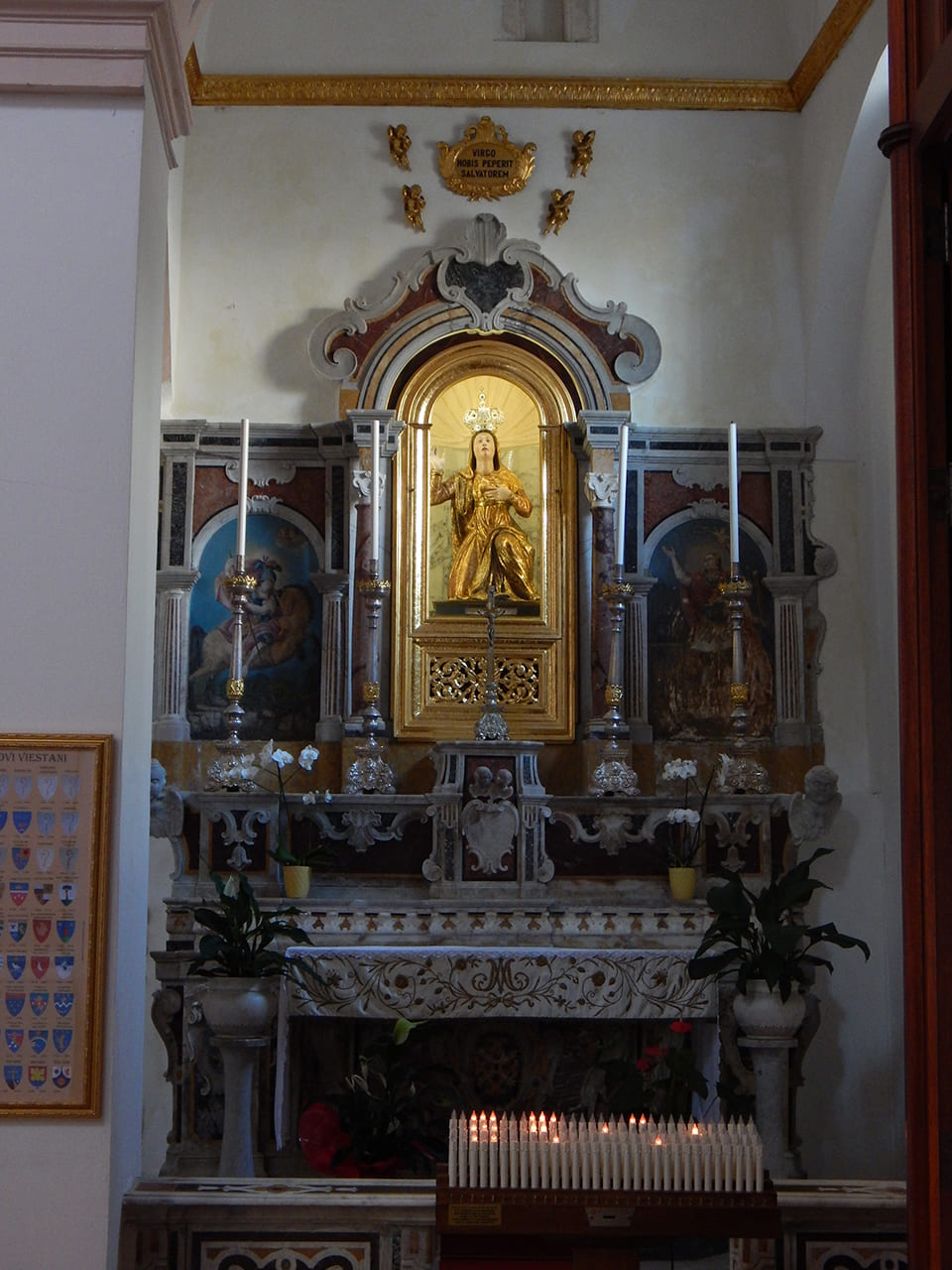
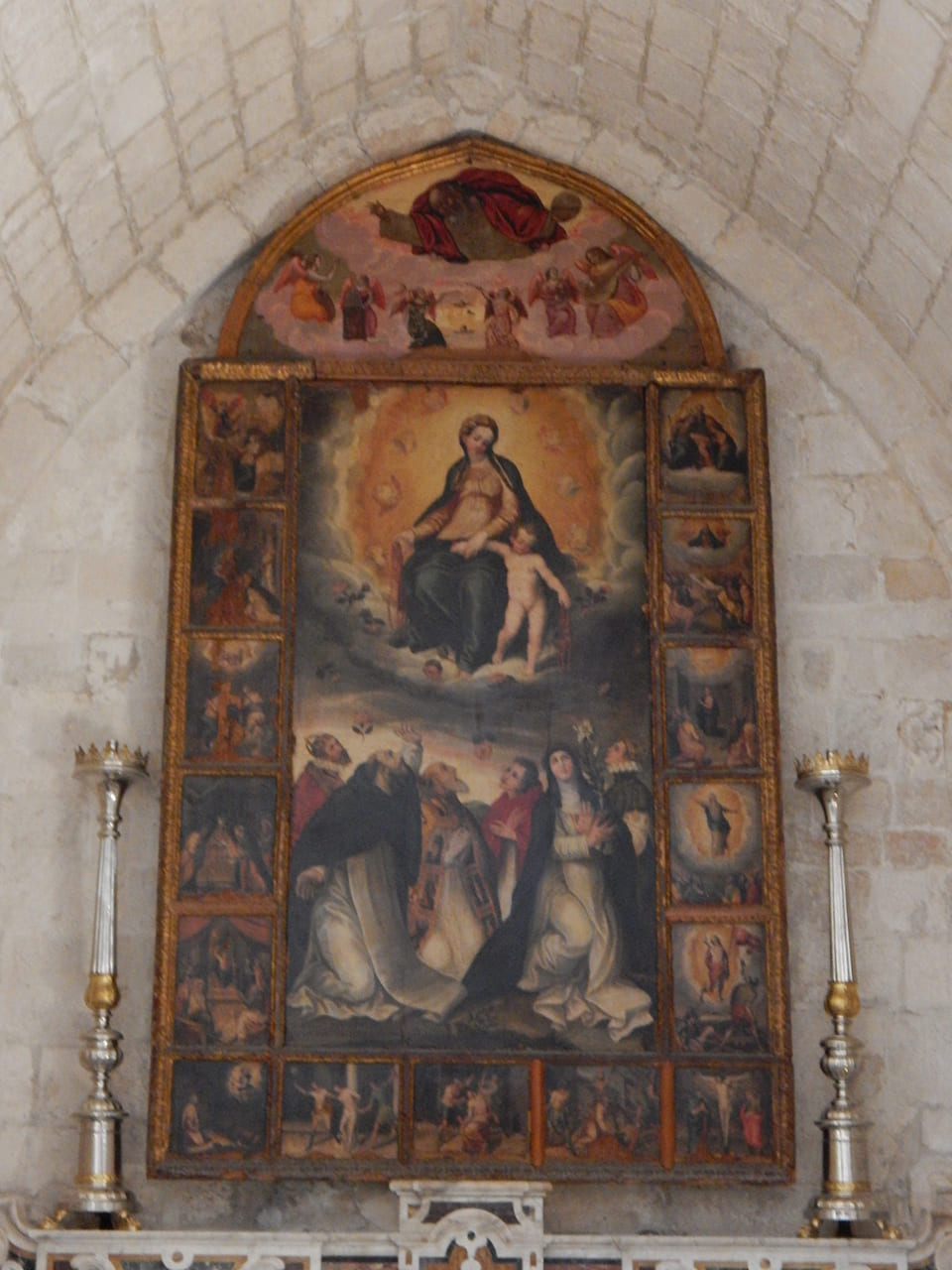
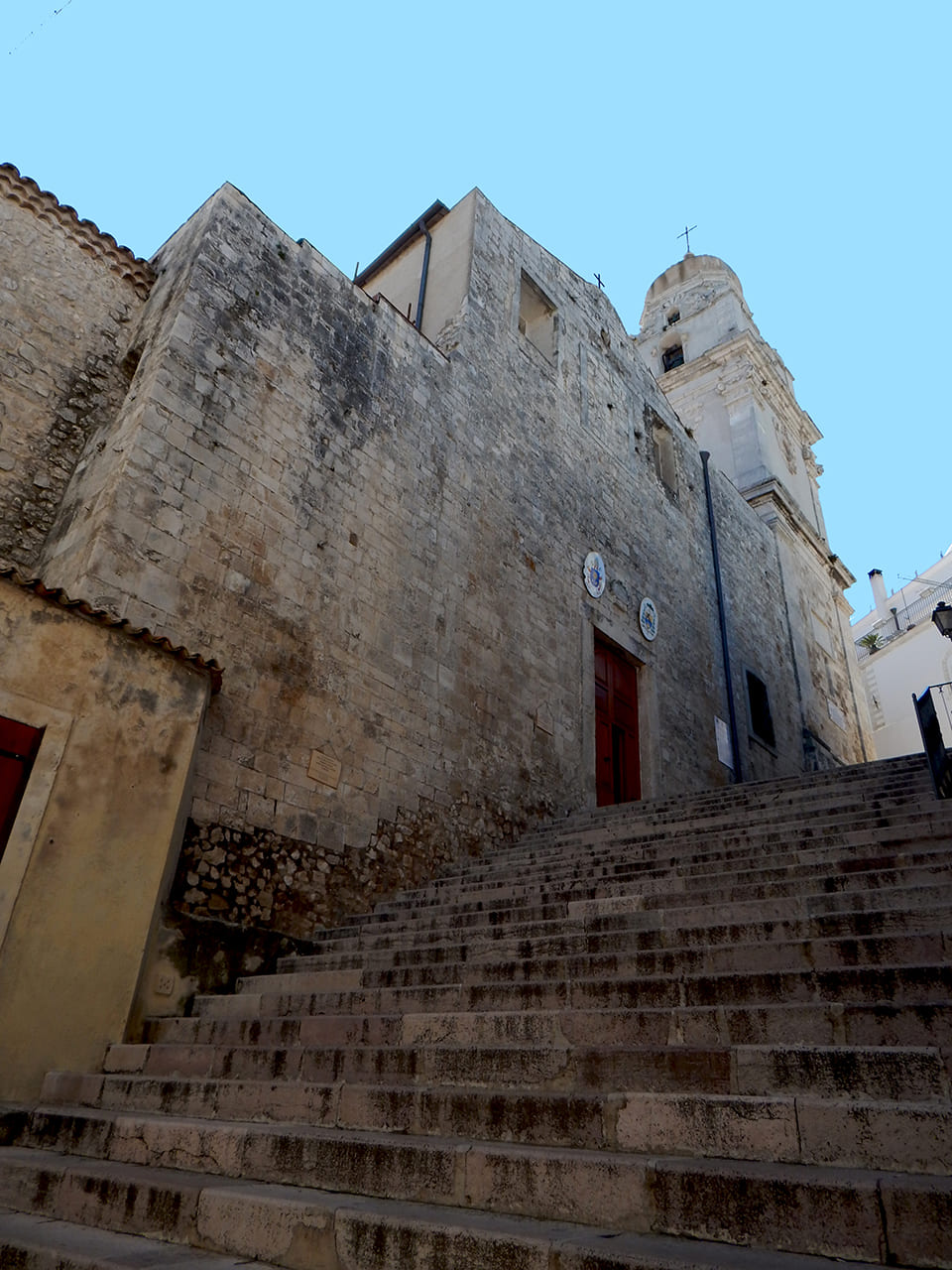
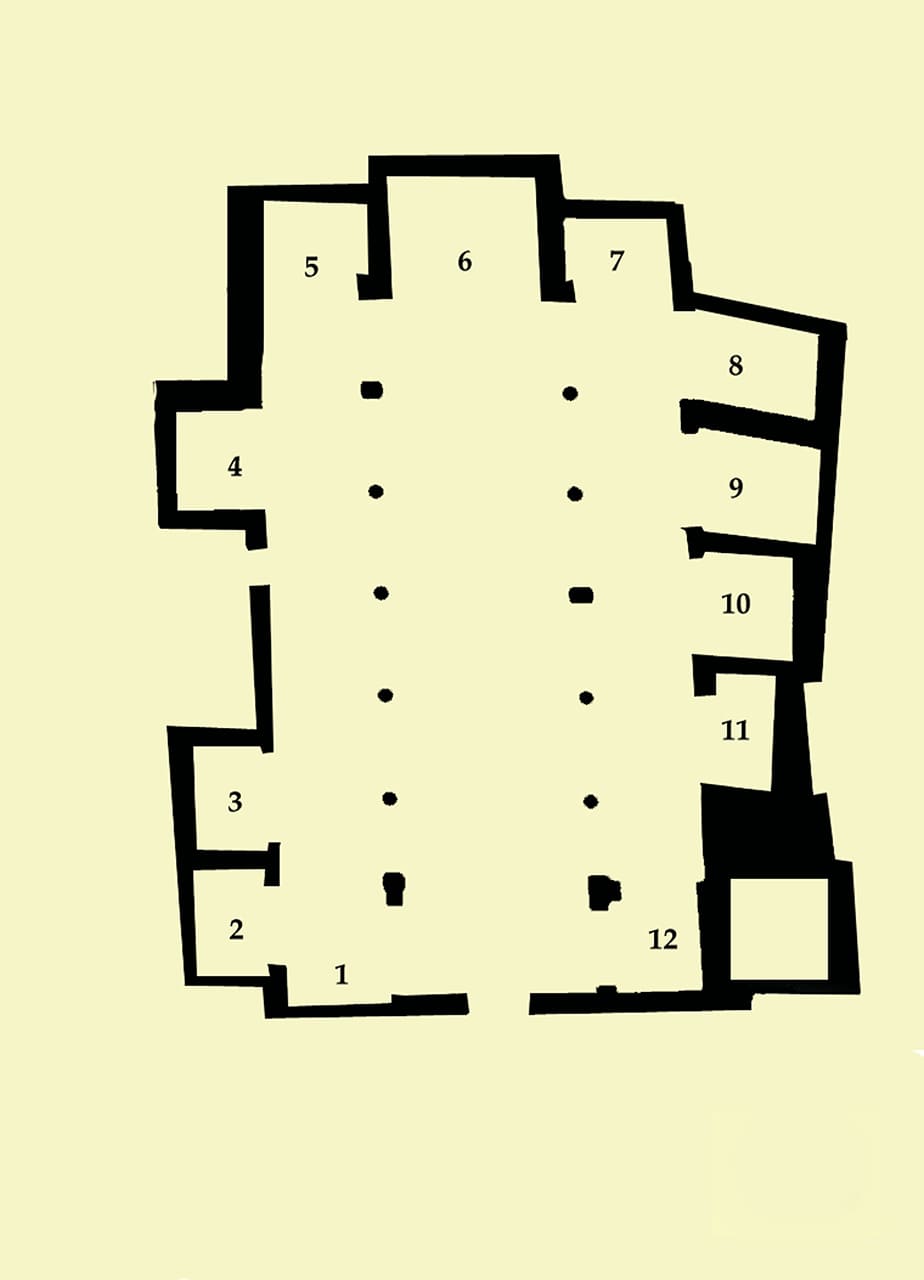
Passing by the main entrance, on the left side, we can see the “Casse” of Madonna (1) used to carry the protector of the city in a solemn procession. The first is the large one, carried on the shoulder by the confreres in the town, the other smaller, is carried on the shoulder by the people. These two works are made by local artists and considered as real works of art for their originality and symbolism. Continue with the Chapel of the Baptistery (2), the oldest of the church with the marble baptismal font with wooden lid decorated in fake marble by the Neapolitan marmorari Barone. You can also admire the statue of the Immaculate by Nicolantonio Brudaglio (1756), one of the most important works of this Apulian artist.The second chapel is dedicated to St. George (3), the patron saint of the city with the altar made of stone and whitewashed with lime. The statue of St. George dates back to 1961 and replaces an old eighteenth-century sculpture that has been lost. In this chapel are also preserved relics of St. Pio of Pietrelcina donated to this church in the year 2000. The chapel of Our Lady of the Rosary (4) houses an oil painting of 1521 made by the Genoese painter, but Neapolitan by adoption, Michele Manchelli. Next to the main altar is the Chapel of the Holy Trinity (5) with an eighteenth-century altar dedicated to the souls of Purgatory coming from the nearby former church of San Giovanni surmounted by a marble aedicule with the altarpiece of the Trinity made by the local painter Giuseppe Tomaiuoli. On the sides of the chapel are arranged two canvases: The Deposition of Christ from the Cross by Villani 19th century) and a canvas by Di Jasio painted in the ealy of 20th century. The High Altar (6) on the other hand, modified after the Council, features a marble altar of 1719 made by Bishop Antonio Maruca and surrounded by the wooden choir of 1769 with the coat of arms of Bishop Cimaglia. At the top is present the painting made by Luigi Velpi: The expulsion of the vendors from the Temple carried out in 1779. The nave is covered by a wooden ceiling painted in tempera of the Neapolitan school and depicts a false vault enriched by three large medallions painted on canvas depicting: Saint Michael, protector of the Gargano; the Assumption of Our Lady, titular of the cathedral and St. George patron saint of the city of Vieste.The whole work was commissioned after 1750 by Monsignor Cimaglia and made by the pupils of Tomaiuoli to the master’s design. The saints depicted give their names to the three districts of the historic centre. To the right of the high altar is the Chapel of the Sacrament (7), dating back to 1771, richly adorned with marble with a painting of the Venetian school depicting a Sacred Conversation in which St. John the Baptist gives flowers to the Virgin Mary through an angel in the presence of St. Joseph, patron saint of carpenters, and St. Crispino patron saint or shoe-miths. In the nave on the right there are five chapels closing the southern side of the church. The first chapel is dedicated to Our Lady of Sorrows (8) and also houses the statue of the Dead Christ donated by the Medina family who held the jus patronage of the chapel for centuries. These statues are carried in procession on Good Friday. Next is the Chapel of St. Anne (9), now used as a small lapidarium, there are finds belonging to the main facade erected in the 11th century and a cover of a sarcophagus of the 7th century. The next one is the Chapel of St. Michael (10) with a statue of the three Archangels Raphael, Michael and Gabriel, to note the bas-relief of the Michelangelo school in Carrara marble of the end of the 15th century gift to the city of Pope Gregory XIII. Hanging on the eastern wall is the transcript of a document in which the Pope grants the purchase of Indulgences in a particular way in this chapel. The penultimate chapel instead is dedicated to St. Francis of Paola (11), protector of sailors, which today also contains the relics of the city, including those of St. Francis of Paola and the relics of the catacombs of St. Sebastian in Rome brought by the nephew of Pope Sixtus V in 1590. At the end of the nave there is the Chapel of the People (12) erected in 1621 at the expense of the city of Vieste and dedicated to the Annunziata, in the niche there is the wooden image of Santa Maria di Merino, protectress of the city which is celebrated with great solemnity every May 9th. The altar was erected at the expense of the people of Vieste in 1617 and enriched with precious marble in 1768 while the lateral frescoes with St. George and St. Ponziano and the marble decorations are made in 1771 by the Petrone family.
Der Besuch beginnt links vom Haupteingang, wo sich zwei “Casse” (1) befinden, mit denen die Beschützerin der Heiligen von Vieste während der Prozession weitergeführt wird Sie werden von lokalen Künstlern hergestellt. Der erste wird in der Stadt verwendet, und der zweite wird während der Pilgerreise verwendet. Als nächstes befindet sich die Baptisteriums Kapelle (2), die älteste in der Kirche, die aus Marmor und Holzdeckel besteht und von den neapolitanischen Marmor Bildhauern Barone hergestellt wurde. Es gibt auch die beeindruckende Statue der Immacolata von Nicolantonio Brudaglio (1756). Die zweite Kapelle ist dem Heiligen Schutzpatron von Vieste, San Giorgio (3), gewidmet. Der Altar von 1700 ist original, aber die Statue wurde 1961 ersetzt. In dieser Kapelle befinden sich auch die Reliquien von San Pio aus Pietrelcina. In der Kapelle der Madonna del Rosario (4) befindet sich das einzige Ölwerk des genuesischen Malers Michele Manchelli aus dem Jahr 1521. In dieser Kapelle ruht auch der Priester aus Vieste, Don Antonio Spalatro. Neben dem Hauptaltar befindet sich die Dreifaltigkeitskapelle (5) mit einem Altar der Kirche San Giovanni aus dem Jahr 1700 für die Seelen des Fegefeuers und einem Marmor-Altarbild der Dreifaltigkeit des lokalen Malers Giuseppe Tomaiuoli. An den Seiten der Kapelle befinden sich zwei Gemälde: Die Darstellung Christi vom Kreuz von Villani aus dem 19. Jahrhundert und ein Gemälde von Di Jasio zu Beginn des 20. Jahrhunderts. Der Hochaltar (6) wurde nach dem Konzil umgebaut. Es hat einen Marmoraltar von 1719, durch den Bischof Antonio Maruca wollte. Es ist von einem Holzchor aus dem Jahr 1769 mit dem Wappen des Bischofs Cimaglia umgeben. Auf der Oberseite befindet sich ein Gemälde von Luigi Velpi aus dem Jahr 1779: “La cacciata dei venditori dal Tempio”. Das Mittelschiff ist von einer mit Tempera bemalten Holzdecke bedeckt. Es wurde nach 1750 vom Bischof Cimaglia in Auftrag gegeben, von Tomaiuoli entworfen und von seinen Schülern bemalt. Das Gemälde zeigt: Saint Michele, Beschützer von Gargano; die Himmelfahrt der Jungfrau Maria, die der Kathedrale gewidmet ist; San Giorgio der Patron von Vieste. Diese drei Heiligen repräsentierten die drei Bezirke der Altstadt. Rechts vom Hauptaltar befindet sich die mit Marmor verzierte Kapelle des Allerheiligsten Sakraments (7) von 1771 und ein Gemälde des Sakralgesprächs mit San Giovannino Battista, das der Madonna die Blumen durch einen Engel schenkt. Es gibt auch San Giuseppe und San Crispino. Das rechte Kirchenschiff hat fünf Kapellen. Die erste ist der Madonna Addolorata (8) mit der Statue des toten Christus gewidmet, die von Medinas Familie gestiftet wurde. Die nächste ist die Kapelle von Sant’Anna(9), es gibt ein kleines Lapidarium mit den Resten der ursprünglichen Fassade des XI Jahrhunderts und einen Sarkophag des VII Jahrhunderts. In der nächsten Kapelle von San Michele (10) befinden sich die Statuen der drei Erzengel. Das Basrelief besteht aus Carraras Marmor, der von Papst Gregorio XII. gestiftet wurde. Die Kapelle San Francesco aus Paola (11), Beschützer der Seeleute, beherbergt die Reliquien der Stadt, darunter San Francesco aus Paola und aus den Katakomben von San Sebastiano in Rom, die 1555 vom Neffen von Sisto Papst V. geschenkt wurde. Die letzte Kapelle ist die 1621 erbaute Volkskapelle (12), die von der Stadt Vieste bezahlt wurde. Es ist der Annunziata gewidmet, in der Nische befindet sich die Holzstatue von Santa Maria von Merino, der Beschützerin der Stadt. Sie wird jeden 9. Mai gefeiert. Der Altar wurde 1617 vom Volk von Vieste bezahlt und 1768 mit dem kostbaren Marmor angereichert. Die Gemälde an den Seiten von San Giorgio und San Ponziano stammen aus dem Jahr 1771 zu Ehren von Petrones Familie.
